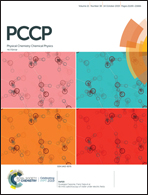Molecular dynamics investigations of oligosaccharides recognized by family 16 and 22 carbohydrate binding modules†
Abstract
As a non-catalytic domain, carbohydrate binding modules (CBMs) are often considered to play some key roles in the degradation and recognition of polysaccharides catalyzed by cellulases. In this work, we investigated the recognition dynamics of cello- or xylo-saccharides by two typical CBMs (CBM16-1 and CBM22-2), which are grouped into Type B CBMs. By combining extensive molecular dynamics, principle component analysis, and binding free energy calculations, we constructed several complex models of the two CBMs in both complex cello- and xylo-oligosaccharides. The corresponding substrate recognition affinity and critical residues having significant contributions were systematically investigated. The residues containing aromatic side chain groups were shown to contribute significantly to substrate binding. The calculated binding free energies were in fairly good agreement with the experimental measurements with the absolute mean error of 0.69 kcal mol−1. The overall electrostatic interactions were shown to have negative effects on substrate recognition. Further metadynamics simulations revealed the substrate dissociation process.



 Please wait while we load your content...
Please wait while we load your content...